So the tires of your bicycle are flabby and squishy. Bicycling with flat-ish tires can ruin your rims! Drop by one of these locations so that your bicycle can inhale some much-needed air. If you've a flat, learn how to fix it, or enlist the help of a Bicycle Shop. This Google Map shows the location of most of these pumps.
When pumping up at gas stations, you typically face a 50-75 cent fee. California law states that air is free for cars purchasing gas, which is irrelevant in a bicycle's case, but you can often just go inside and ask them to turn on the air without being questioned. You might not want to go this route, however, because gas station air compressors will often blow bike tires up.
Many Bicycle Repair Stations have pumps, as well as tools for making repairs.
Pump Locations
Note: pictures of the harder-to-find locations would be helpful ...
Most of the pumps listed below are for tires with Schrader valves (the type you'd see on car tires). If you have a higher end bike, you'll probably have Presta valves on your tires, which won't work with these pumps! There is hope, however. Most bike shops carry Schrader to Presta adaptors for about $1.
Campus-Affiliated Pumps
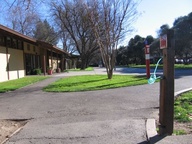 View of the Regan bike pump, with Regan Main in the background
View of the Regan bike pump, with Regan Main in the background  Tercero
Tercero
- Bike Barn - only during bike barn hours (10am-4pm weekdays), otherwise they bring it in
- Castilian South — on the wall of the building facing the bike parking below the roof
- UC Davis Fire Department Fire Dept/Police Station] in a courtyard behind the fire department, on the south side of the police station (not accessible from Kleiber Hall Drive). Enter from the alleyway that runs along the north side of the West Entry Parking Structure.
-
TAPS Just south of the business entrance on the Hutchison Field bike path.
Right next to this pump there is recently installed Bike Repair station with several tools and a manual pump.
If there are a few more maybe they are worthy of an independent wiki entry.
- Memorial Union — on the west side of the Catering trailer near the bike racks. This pump has a pressure gauge, but unfortunately only goes up to 45 PSI.
- Regan Main — near the bike circle outside of the main complex, available all the time. This pump only fills up to 95 PSI; most road bikes need more pressure than that, but it's a useful temporary solution for a flat tire.
- Segundo North — on the eastern-most side and the new Bike Station (or Fixit) right next to it.
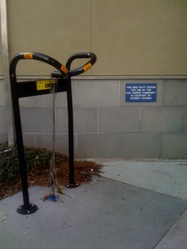 Segundo's Public Bike Repair Station
Segundo's Public Bike Repair Station
- Shields Library — left of the bike path passing directly in front of the library's SW face, on Hutchinson. In addition to a hand pump, this repair station has a set of tools.
- Solano Park — corner of the 3300 building
- Tercero J Building — off Bioletti Drive
- Tercero South — in the courtyard between Kearney and Laben, near the gate to Dairy Road. This pump has a pressure gauge.
- Thoreau Hall — in the underground parking structure, near the maintenance room
- Webster Hall — behind the building, on the Russell Boulevard side
Downtown Pumps
- APEX Cycles
- B&L Bike Shop
- Whole Foods Market - Part of the repair station by the bike racks in the parking lot.
East Davis Pumps
- George's Auto Repair — Mechanics who work here are friendly, just ask, it's free.
- Bike Forth has a selection of pumps available during its normal hours for both Schrader and Presta valves.
North Davis Pumps
- Anderson Road Chevron — charges $0.75
- Davis Shell
West Davis Pumps
Mobile Bike Pumps
- pxl always brings a pump with him on his orange fishbike. If you see the fish and need a pump, just ask.
- Aaron.Curtin of APEX Cycles always has a pump, tubes and basic bike tools in his truck. If you see him at the park or around town and need some help, just ask. If he can't help you right there, he'll load your bike up and give you a ride to the shop.
South Davis Pumps
 The Oakshade pump has a fancy plaque above it
The Oakshade pump has a fancy plaque above it
- On the wall near the former Davis Creamery in Oakshade Town Center
this one hasnt worked for awhile. Maybe the air compressor isn't plugged in?
How to fill up your tire
The first thing you'll need to know is what type of valve you have on your bike. Most valves are either Schrader (common on mountain bikes and cruisers) or Presta (common on road bikes). Most pumps around town are for Schrader valves (which are also used for cars), so you may need to purchase a Presta-to-Schrader adapter (about $5 or less at any bike shop) to use these pumps around town.
Next you'll need to see how much pressure your tire can take. For some pumps you can just inflate your tire until it stops inflating, but beware — there are many pumps that will pop your tube if you over-inflate (especially at places like gas stations)! Your tire will likely have a maximum amount of pressure it can take written on the side of the tire. Look at that figure and inflate no more than that point. It's usually around 40 psi for mountain bikes, 80 psi for hybrids, and 120 psi for road bikes — but make sure you check yourself. If you have a mountain bike or hybrid, you'll probably want to run the pressure at or close to the max rating when on pavement. If you're going off road, run the pressure a bit lower for more shock absorption.
Bike tires can lose up to 10 psi per week, whether you're riding or not, so regularly checking your tires is a good idea.
2007-08-12 00:54:41 Does anyone know who maintains the "public" pumps (e.g., the Oakshade one)? I've gone there and it's been out of air, and the people in the nearby businesses don't know whom to contact. —KevinChin
2008-09-21 15:41:18 Which of these have pressure gauges on them? The picture of the Oakshade one shows that it clearly does not. —RobertM525
-
Very few of them, if any. I've never even seen one with a gauge on them. Your best bet is to buy a cheap gauge from any of the bike stores around town, or better yet, buy your own hand pump with a built in gauge. —AlexanderHo
- You gotta learn to do it by feel, use the force. —GarrettGallegos
2010-09-02 14:30:30 Yesterday (9/1/10) both the Regan Main and TAPS pumps were out of order. —GJC02


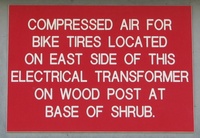
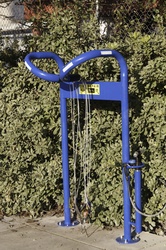
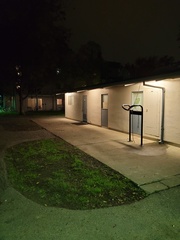


Comments:
You must be logged in to comment on this page. Please log in.